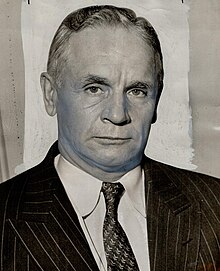John Bracken | |
|---|---|
 | |
| Leader of the Opposition | |
| In office 11 June 1945 – 20 July 1948 | |
| Preceded by | Gordon Graydon (acting) |
| Succeeded by | George A. Drew |
| Leader of the Progressive Conservative Party of Canada | |
| In office 11 December 1942 – 20 July 1948 | |
| Preceded by | Arthur Meighen |
| Succeeded by | George A. Drew |
| Member of Parliament for Neepawa | |
| In office 11 June 1945 – 27 June 1949 | |
| Preceded by | Frederick Donald Mackenzie |
| Succeeded by | Riding abolished |
| 11th Premier of Manitoba | |
| In office 8 August 1922 – 14 January 1943 | |
| Monarchs | George V Edward VIII George VI |
| Lieutenant Governor | James A. M. Aikins Theodore A. Burrows James D. McGregor William J. Tupper Roland F. McWilliams |
| Preceded by | Tobias Norris |
| Succeeded by | Stuart Garson |
| Member of the Legislative Assembly of Manitoba for The Pas | |
| In office 5 October 1922 – 14 January 1943 | |
| Preceded by | Edward Brown |
| Succeeded by | Beresford Richards |
| Personal details | |
| Born | 22 June 1883 Ellisville, Ontario, Canada |
| Died | 18 March 1969 (aged 85) Ottawa, Ontario, Canada |
| Political party | Progressive Conservative (federal) Progressive Party of Manitoba (provincial) |
| Spouse |
Alice Wylie Bruce (m. 1909) |
| Children | 4 |
| Alma mater | |
| Occupation |
|
| Cabinet | President of the Council (1922–1943) Minister of Education (1922–1923) Provincial Lands Commissioner (1922–1923) Railway Commissioner (1922–1923, 1935–1940) Minister of Agriculture (1923–1925, 1936) Provincial Treasurer (1925–1932) Minister of Public Utilities (1927–1928) Minister of Mines & Natural Resources (1928–1930) Provincial Secretary (1935–1939) Minister Manitoba Power Commission (1936–1940) Minister, Dom. Prov. Relations (1939–1940, 1941–1943) |
John Bracken PC (22 June 1883 – 18 March 1969) was a Canadian agronomist and politician who was the 11th and longest-serving premier of Manitoba (1922–1943) and later the leader of the Progressive Conservative Party of Canada (1942–1948).[1][2]
Bracken was born in Ontario, and was a professor of animal husbandry at the University of Saskatchewan before moving to Manitoba in 1920. A political outsider, he was named leader of the Progressive Party of Manitoba following its upset victory in the 1922 Manitoba general election. During his tenure as premier of Manitoba, he implemented independent, non-partisan policies dominated by rural interests and opposed organized labour. He oversaw the creation of a universal pension, the provincial income tax, and reductions in spending on health, education and welfare as well as the replacement of the first past the post voting system with alternative voting. He pursued development by promoting staple industries such as mining, timber and fishing. After leading the Progressive Party to a second consecutive majority in the 1927 election, he merged the Progressive Party with the Liberal Party of Manitoba to form the Liberal-Progressive Party in 1932. He led the Liberal-Progressive Party to consecutive victories in elections in 1932, 1936 and 1941, winning majority governments in all but the 1936 election.
In 1942, he agreed to run for the leadership of the federal Conservative Party of Canada at the condition that the party be renamed the Progressive Conservative Party of Canada. After being elected leader of the newly renamed party, he resigned as premier of Manitoba and led the PCs to a second-place finish during the 1945 Canadian federal election against the incumbent Liberal Party government led by Prime Minister William Lyon Mackenzie King. He resigned as leader of the party in 1948 and was succeeded by George A. Drew. After being defeated while running for reelection to the House of Commons in the 1949 federal election, he retired from politics and died in 1969.